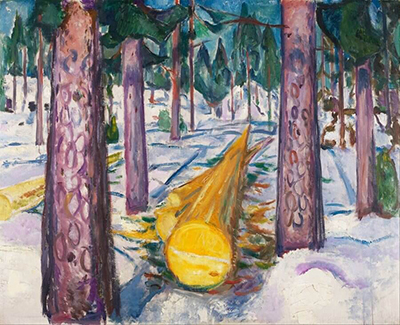Edvard Munch created many wooded landscapes with logs in the winter of 1911-12. He had a strong connection with woodland motifs that manifested human activities. One such painting was the Yellow Log.
In the picture, you will easily detect Munch's strong passion for dramatic perspectives. The log is lying in the deepest parts of the forest. If you observe closely and follow the log's line in the picture, your eyes will be attracted to the pine woods, where the log is caught in a tree trunk. This is clearly an exaggerated perspective, but Munch leverages it to give his audience the impression of movement. Based on where you stand, you will see that the log changes positions like it is in motion. For instance, if you view from the left, you will see the log slopes into the painting from that side, and vice versa.
If you try to move back and forth front with your eyes fixed on the painting while wandering among the tree trunk, you will see three-dimensional effects in some sections of the picture. He used complementary colours; purple and yellow, which is in strong contrast with each other. That way, Munch manages to give his audience a perfect illusion of movement. Edvard Munch is an artist who loved nature. In most of his work, he painted landscapes in forests and gave them different names. Today, it is believed that the names were suggested based on the message he was trying to pass and how he felt when he created each of his paintings. David Hockney would later make use of influences from Munch, as far as we can tell, in a number of his landscape paintings within the UK, such as More Felled Trees on Woldgate and The Arrival of Spring in Woldgate East Yorkshire. Additionally, Gustav Klimt covered the Austrian countryside many times, with the likes of Tannenwald and Beech Forest.
Unlike other artists, Edvard Munch, when he created the yellow log, had gained adequate skills to balance colours to capture his audience's attention and regulate their emotions. Such skills made him stand out. However, when he was just getting started, his home critics said his work was gibberish, but that never stopped him. Munch lived in a small town close to Oslo, which he visited many times in 1888. He lived in a small house that he rented after his career kicked off. Some of his work was based on the memories he created with his first love. He had a young sister called Inger, who modelled for most of his paintings. Today, you can see the Yellow Log painting in the Munch Museum, Oslo. The painting has been held there for many years and is of medium size.




